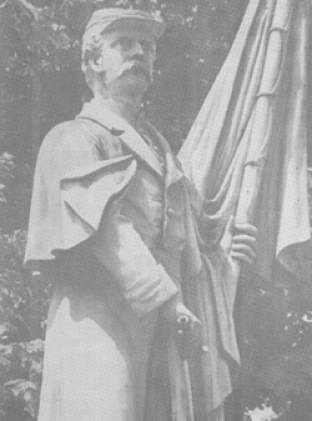The "Roving" Sentinel
This statue familiar to all who live in or near East Liverpool has resided in the city for many years but has stood as "Sentinel" watching the former Confederacy in several different locations throughout the city.
"He stands on guard, sternly facing the direction of the former Confederacy, one hand grasping his sword, the other clutching Old Glory." This statement appeared in the East Liverpool Historical Society publication "Hills & Kilns" in September 1990 marking the 100th year that the Sentinel had stood in the city.
More than 20 years after the close of the Civil War a group of local citizens petitioned the City Council to purchase a monument in memory of Civil War soldiers, In 1888 a committee solicited for $3,000 to obtain a monument to be erected in the Diamond. The statue was manufactured by the Monumental Bronze Co. of Bridgeport Connecticut. It stands 23 feet (including the base) and is made of a mixture of zinc, tin, and copper and weighs about 4 tons.
The cornerstone on the Diamond was laid on Memorial Day, May 32, 1890. Unveiling of the statue occurred at a two day gala event on October 1 & 2, 1890. The first day was for the dedication and reunions for veterans including a free dinner for them held at the skating rink on 5th Street.
Local pottery owners and other firms declared two days off for employees and Governor James Campbell was the keynote speaker.The Sentinel remained at the Diamond for less than a decade when it was removed to the City Park in 1909 (near the old cemetery). Seven years later in 1916 it was relocated to the front of the Carnegie Library.
In 1942 it was finally moved to the Riverview Cemetery where it stands today located next to the GAR Chapel and the tract of the cemetery designated for veterans of the Civil War and subsequent wars.
For several years the sword was missing from the right hand but was found and repaired and replaced in the 1970's.
Locals have thought that the statue may have been modeled after William Surles, a Civil War veteran and Congressional Medal of Honor winner who resided in East Liverpool after the war but it is apparently drawn from a mold which produced many other statues in the 19th Century.

